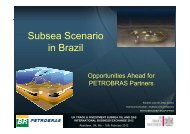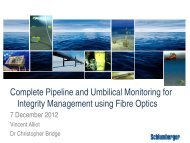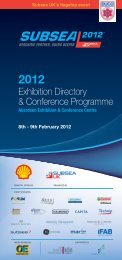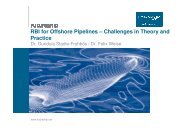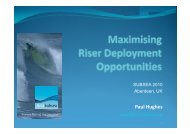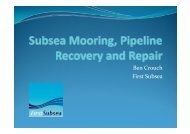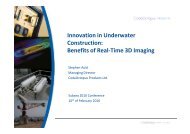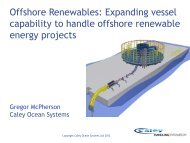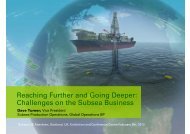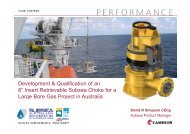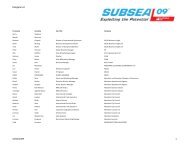Patrick Collins - Aubin - Subsea UK
Patrick Collins - Aubin - Subsea UK
Patrick Collins - Aubin - Subsea UK
You also want an ePaper? Increase the reach of your titles
YUMPU automatically turns print PDFs into web optimized ePapers that Google loves.
GLS – New Technology Rising to<br />
the Challenge of <strong>Subsea</strong> lifting<br />
<strong>Subsea</strong> 2012<br />
Paddy <strong>Collins</strong>
Introductions<br />
<strong>Aubin</strong><br />
• Design, Develop and Supply own<br />
chemical technical technology<br />
– Cement and Stimulation<br />
– Pipeline products<br />
– <strong>Subsea</strong><br />
• Technology Supply<br />
Ecosse <strong>Subsea</strong><br />
• <strong>Subsea</strong> Lifting<br />
• Trenching<br />
• Technology development<br />
• People<br />
• Technology Execution
“Pumpable” Buoyancy<br />
Gel Lift System<br />
• Incompressible Low density<br />
Liquid<br />
• Density 550 - 580 Kgs/M 3<br />
• Rated to 150M GLS<br />
• Rated 3000m DeepBuoy<br />
• Tranferable “pumpable”<br />
buoyancy<br />
• Buoyant force independant of<br />
depth (unlike air bags)<br />
• Patented technology
Buoyancy<br />
• An object floats when its average<br />
density is lower than fluid density<br />
• Buoyancy depends on submerged<br />
volume and density<br />
• We can increase buoyancy by<br />
attaching a container full of air to<br />
reduce the average density of the<br />
object<br />
• So whats wrong with Air?
Whats wrong with Air?<br />
• Gas is Compressible<br />
• Boyles Law<br />
P 1<br />
V 1<br />
= P 2<br />
V 2<br />
As you go Deeper<br />
Volume & Buoyancy<br />
decrease<br />
As you come from Depth<br />
Volume & Buoyancy<br />
Polaris Missile Effect<br />
Air gives you Buoyancy<br />
but doesn’t give you Control<br />
Robert Boyle 1627 -1691
Standing still<br />
Density of Steel - Kg/m3 7850<br />
Density of Seawater -Kg/m3 1020<br />
Density of DeepBuoy Kg/m3 585<br />
Buoyant Force per M3 DeepBuoy Kg/m3 435<br />
Volume of 1MT steel m3 0.1274<br />
Weight of 1 MT Steel in Seawater Kg/m3 870<br />
Bag containing 2.3m 3 DeepBuoy<br />
provides enough lift to make<br />
1MT neutrally buoyant<br />
Volume of DeepBuoy M3 needed to lift 1MT steel 2.30<br />
Buoyant force of gel = Weight of steel in water<br />
Load is neutrally buoyant
Going Up<br />
Density of Steel - Kg/m3 7850<br />
Density of Seawater -Kg/m3 1020<br />
Density of DeepBuoy Kg/m3 585<br />
Buoyant Force per M3 DeepBuoy Kg/m3 435<br />
Volume of 1MT steel m3 0.1274<br />
Pump 23 litres of Gel into bag<br />
increases lift by 10 kgs object<br />
rises in a controlled manner<br />
Weight of 1 MT Steel in Seawater Kg/m3 870<br />
Volume of DeepBuoy M3 needed to lift 1MT steel 2.30<br />
Buoyant force of gel = Weight of steel<br />
in water plus 10 kg Load Rises in a<br />
controlled manner
Going Down<br />
Density of Steel - Kg/m3 7850<br />
Density of Seawater -Kg/m3 1020<br />
Density of DeepBuoy Kg/m3 585<br />
Buoyant Force per M3 DeepBuoy Kg/m3 435<br />
Volume of 1MT steel m3 0.1274<br />
Pump 23 litres of Gel OUT of the<br />
bag reduces lift by 10 kgs object<br />
Sinks in a controlled manner<br />
Weight of 1 MT Steel in Seawater Kg/m3 870<br />
Volume of DeepBuoy M3 needed to lift 1MT steel 2.30<br />
Buoyant force of gel = Weight of steel<br />
in water minus 10 kg Load Sinks in<br />
a controlled manner
Orkney Trial<br />
• Placed and recovered a one tonne object on the seabed<br />
successfully<br />
• Simple system using modified air bags and air driven<br />
diaphragm pump<br />
• Very high level of control<br />
• Very easy to use compared with air bags<br />
• Has since generated considerable interest in the diving<br />
community<br />
• Video taken and posted on YouTube<br />
• http://www.youtube.com/watch?v=QG5ja9-AI2s
Possible Applications<br />
• Safety critical lifts requiring neutral buoyancy next to live lines<br />
• Suction Pile installation<br />
• ROV construction work (10Te subsea crane)<br />
• Pipelay top tension reduction,<br />
• Deepwater bundles<br />
• Deepwater module removal and replacement<br />
• Device and mooring installation for renewables<br />
• Lateral transport of heavy loads where crane access is not possible<br />
• <strong>Subsea</strong> manifold installation in much larger units than currently envisioned<br />
• <strong>Subsea</strong> mining (transport of ore and tooling to surface)<br />
• Renewables installation<br />
• Decommissioning of WHPS, manifolds, all subsea oil field bric a brac<br />
• Deepwater Salvage<br />
• Mid water riser arches, deep water riser arches<br />
• Air bag replacement for diver operations
Lifting with ROV’s<br />
http://www.aubin.co.uk/subsea_deepbuoy.htm
Decommissioning <strong>Subsea</strong><br />
WHPS on seabed approx. 5m h x 13m x 13m<br />
Assume WHPS piles cut 3m below bottom horizontal<br />
member<br />
“…because we think differently”
MFE Equipment Used to Clear Seabed Surrounding Pile Bases<br />
“…because we think differently”
Shear Cutter Severs Piles 3m Below Seabed<br />
“…because we think differently”
Neutrally Buoyant 4 x 8m x 3m diameter Silos Attached<br />
to Structure Lower Horizontal Members with Slings<br />
“…because we think differently”
4 off. 8m x 3m Diameter Cylinders Provide up to 125Te of Lift<br />
with GLS<br />
“…because we think differently”
Using Gel to Control Ascent, Structure Brought to<br />
Surface. Draft Approximately 6m<br />
“…because we think differently”
250 Tonnes of Lift by Replacing Gel with Air Reduces Draft<br />
to Approximately 4m<br />
“…because we think differently”
Tow Structure to Port of Choice<br />
“…because we think differently”
Lifting frame designs
Opportunity<br />
Market Segmentation<br />
<strong>Subsea</strong> Installation<br />
GLS<br />
Cost is determined by depth and size<br />
of object to install.<br />
Vessel availability / competition<br />
diminishes as you go deeper and<br />
heavier.<br />
DeepBuoy<br />
100 Mt 100 M<br />
“Straightforward”<br />
1000+ Mt 100M<br />
“Difficult &<br />
Expensive”<br />
Barriers to Entry increase as you go<br />
deeper and heavier<br />
The move to subsea processing means<br />
there is an Increasing need to put<br />
bigger objects to greater depths<br />
100 Mt 1000+M<br />
“Difficult &<br />
Expensive”<br />
1000+ Mt 1000+M<br />
“Impossible”
Doing the Impossible<br />
Installation of large structures at depth<br />
• <strong>Subsea</strong> compressor - a very<br />
large very heavy structure<br />
• Need to be installed in pieces<br />
• Big benefits from making the<br />
whole thing at surface and<br />
installing it in one piece<br />
improving reliability by<br />
building and testing the full<br />
system on the beach.<br />
• But how to do it?
Application placing 1000 tonnes to<br />
1000 metres<br />
Trim Tank<br />
Submersible<br />
Barge<br />
Tanks filled<br />
With Gel
Submersible Heavy lift Barges<br />
• Barges can be unpowered or<br />
powered<br />
• Multiple units commercially<br />
available<br />
• Can lift very large loads and take<br />
to site and unload<br />
• Unloaded by controlled “sinking”
Float off structure DeepBuoyGel<br />
Provides buoyancy structure<br />
floats
DeepBuoy is is removed such that<br />
structure is slightly buoyant and winch<br />
“pulls down” structure to location<br />
avoiding heave compensation issues<br />
and ensuring structure is located<br />
correctly.<br />
Vessel with moon pool Fitted with<br />
hoses and pumps and tanks for gel.<br />
Also fitted with a winch . Could use<br />
the heavy lift barge for this<br />
application<br />
Clump weight with sheave is placed on<br />
installation location and winch wire passed<br />
through and up to structure
Structure pulled close to the sea bed – 10 metres<br />
Winch stopped and gel removed until structure is<br />
just less than neutrally buoyant structure starts to<br />
sink very slowly as seen in Orkney trial and ROV’s<br />
guide into place
Once on the seabed pump gel out and<br />
remove lift tanks with winch . Alternatively gel<br />
can remain to be used in subsea construction<br />
and then retrieved
Any questions ?<br />
Please come at visit us at the show stand A42<br />
We have lots more to show you



